To create an authentic tea ceremony at home, you'll need seven essential tools. Start with a quality kettle and fresh water source for ideal brewing. Choose a suitable teapot or brewing vessel for your preferred tea type. Select appropriate tea cups or bowls to enhance the sensory experience. Use a tea scoop or measure for consistent portions. If you're into matcha, a tea whisk is vital for achieving the perfect froth. A tea tray or mat provides a clean, organized workspace. Finally, invest in proper tea storage containers to maintain freshness. Mastering these tools will elevate your tea ritual and deepen your appreciation for this ancient art.
Kettle and Water Source
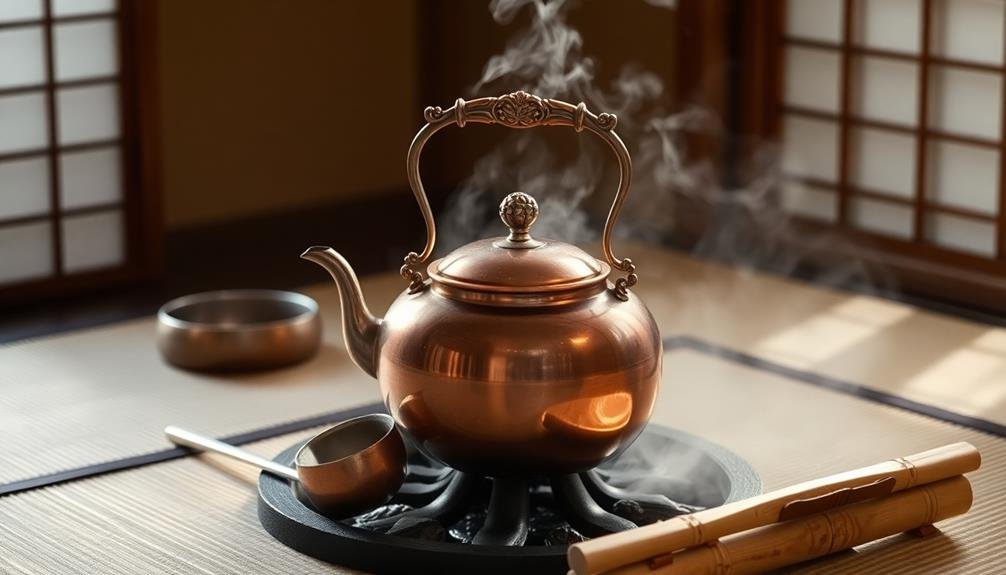
When it comes to the tea ceremony, the kettle and water source are essential elements to kick off your experience.
You'll need a high-quality kettle, preferably made of cast iron or ceramic, to heat your water. These materials help maintain a consistent temperature and add a touch of authenticity to your ceremony.
For the water source, you'll want to use fresh, filtered water. Avoid tap water, as its minerals and chemicals can affect the taste of your tea. Consider investing in a water filtration system or using bottled spring water for the best results.
The temperature of your water is vital and varies depending on the type of tea you're brewing. For green teas, aim for water between 160-180°F, while black teas require hotter water around 200-212°F. A thermometer can help you achieve the perfect temperature.
When heating your water, pay attention to the sound it makes. In traditional ceremonies, the sound of boiling water is often compared to the wind in the pines, creating a meditative atmosphere.
This attention to detail will enhance your overall tea ceremony experience.
Tea Pot or Brewing Vessel
At the heart of your tea ceremony setup lies the tea pot or brewing vessel. This essential tool determines the quality and flavor of your brewed tea. Choose a vessel that suits your preferred tea type and brewing method. For example, a ceramic teapot is ideal for black and oolong teas, while a glass teapot works well for green and white teas.
Consider the size of your brewing vessel based on the number of people you'll typically serve. A small gaiwan is perfect for personal use, while a larger teapot accommodates multiple guests. Pay attention to the spout design, as it affects pouring precision and prevents dripping.
Here's a quick guide to popular brewing vessels:
| Vessel Type | Best for | Material | Capacity | Heat Retention |
|---|---|---|---|---|
| Gaiwan | Oolong, Pu-erh | Porcelain | 100-150ml | Moderate |
| Kyusu | Japanese Green | Clay | 200-300ml | Good |
| Yixing Pot | Oolong, Pu-erh | Purple Clay | 100-200ml | Excellent |
| Glass Teapot | Green, White | Borosilicate | 300-500ml | Poor |
| Ceramic Pot | Black, Herbal | Ceramic | 500-1000ml | Very Good |
Remember to season your teapot if using unglazed clay, as it enhances the tea's flavor over time. Clean your brewing vessel thoroughly after each use to maintain its quality and prevent flavor contamination.
Tea Cups or Bowls
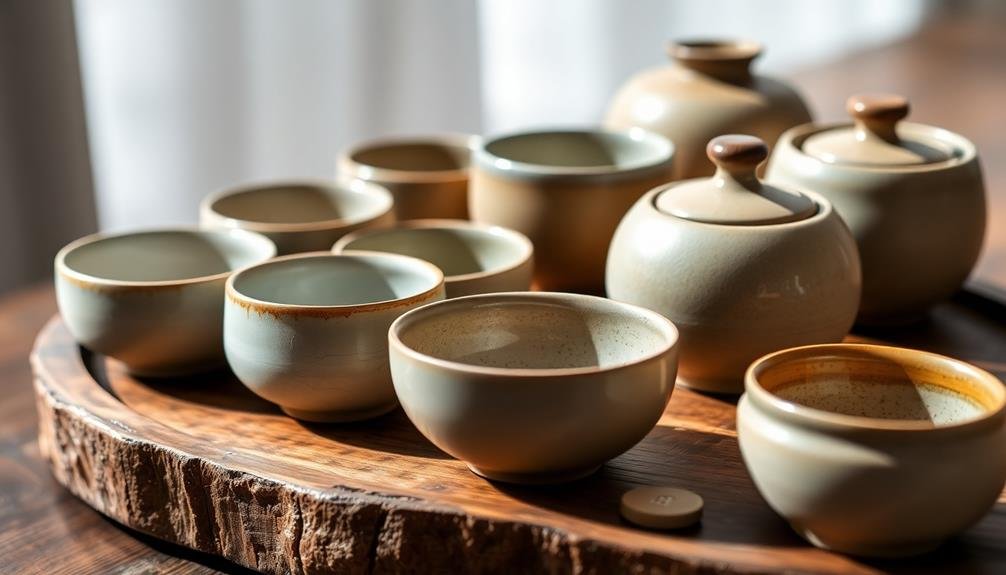
The right tea cups or bowls can elevate your tea ceremony experience. These vessels are essential for serving and enjoying your carefully brewed tea. Traditional Chinese and Japanese tea ceremonies often use small, handleless cups or bowls, allowing you to appreciate the tea's warmth and aroma as you hold them.
For Chinese-style ceremonies, think about porcelain cups with a capacity of 30-50ml. These small cups, known as gong fu cha cups, are perfect for multiple short infusions.
Japanese tea ceremonies typically use larger bowls called chawan, which can hold around 150-180ml of tea. These bowls are often handcrafted and prized for their unique aesthetics.
When selecting tea cups or bowls, pay attention to material, shape, and size. Porcelain and ceramic are popular choices for their heat retention and neutral flavor profile.
The shape of the cup can affect the tea's aroma and taste, so choose ones that complement your preferred tea types. Make sure the size is appropriate for your brewing method and personal preferences.
Don't forget to reflect on the overall aesthetic of your tea set, as visual harmony is an important aspect of the tea ceremony experience.
Tea Scoop or Measure
A tea scoop or measure comes in handy for portioning out the perfect amount of tea leaves for your brew. These tools guarantee consistency in flavor and strength, allowing you to replicate your favorite cup time after time.
Traditional Japanese tea scoops, called chashaku, are made from bamboo and have a long, slender handle with a shallow scoop at the end. They're specifically designed for measuring matcha powder.
For loose leaf teas, you'll find metal or wooden scoops that resemble small spoons. Some come with measurements etched onto the bowl, while others rely on a standard size that typically holds about one teaspoon of leaves.
If you're looking for precision, consider a digital tea scale that can measure down to fractions of a gram.
When choosing a tea scoop, consider the types of tea you drink most often. If you enjoy a variety, opt for a versatile tool that works well with different leaf sizes.
Tea Whisk for Matcha
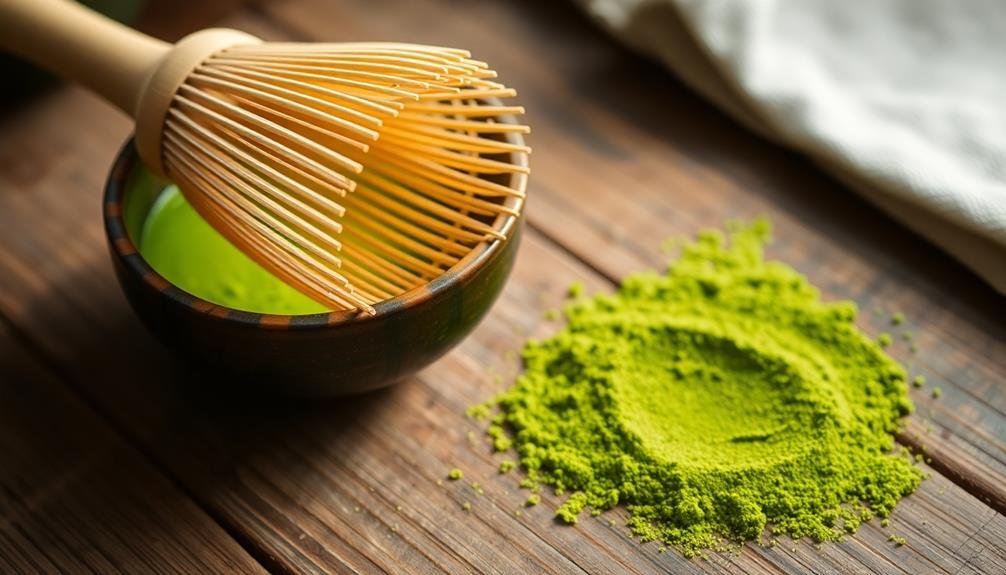
The tea whisk, or chasen, is essential for preparing frothy matcha in traditional Japanese tea ceremonies.
You'll find its bamboo tines expertly designed to aerate and blend matcha powder with hot water, creating a smooth and creamy texture.
To maintain your whisk's integrity, rinse it thoroughly after each use and store it upright in a whisk holder to preserve its shape.
Purpose and Design Features
Made from a single piece of bamboo, the tea whisk, or chasen, serves as an essential tool for preparing matcha in traditional Japanese tea ceremonies. Its purpose is to blend the finely ground green tea powder with hot water, creating a smooth and frothy consistency. The chasen's unique design features numerous thin tines that efficiently break up clumps and incorporate air into the mixture.
When selecting a tea whisk for your home, consider these key design features:
- Number of tines: Usually ranging from 80 to 120, with more tines resulting in a finer froth
- Tine flexibility: Softer tines create a smoother texture, while stiffer ones produce a more robust froth
- Handle shape: Ergonomically designed for comfortable grip and precise control
- Material quality: High-grade bamboo guarantees durability and longevity
The chasen's intricate construction allows it to create the perfect balance of flavor and texture in your matcha. By using gentle, circular motions, you'll achieve a creamy, well-aerated tea with a delicate layer of foam on top.
With proper care and storage, your tea whisk will become an indispensable tool in your home tea ceremony kit.
Proper Care Techniques
Proper care of your tea whisk is essential for maintaining its quality and extending its lifespan. After each use, rinse the whisk thoroughly with warm water to remove any remaining matcha powder.
Don't use soap, as it can damage the delicate bamboo tines. Gently shake off excess water and allow the whisk to air dry completely before storing.
To maintain the whisk's shape, use a special tea whisk holder or stand. This prevents the tines from becoming misshapen and helps the whisk dry evenly.
If you don't have a holder, you can create a temporary stand by placing the whisk upright in a clean, dry cup.
Every few uses, give your whisk a deep clean by soaking it in warm water for about 10 minutes. This helps remove any stubborn matcha residue and rejuvenates the bamboo.
After soaking, rinse thoroughly and dry as usual.
Store your tea whisk in a cool, dry place away from direct sunlight and humidity. Avoid storing it in airtight containers, as this can trap moisture and lead to mold growth.
With proper care, your tea whisk can last for several months to a year before needing replacement.
Tea Tray or Mat
Every tea ceremony setup requires a foundation, and that's where a tea tray or mat comes in. These essential components serve multiple purposes, providing a clean, stable surface for your tea tools and catching any spills or drips during the ceremony.
When choosing a tea tray or mat, consider the following factors:
- Material: Bamboo, wood, or cloth
- Size: Large enough to accommodate your teapot, cups, and tools
- Design: Traditional or modern to match your aesthetic
- Drainage: Built-in systems for collecting excess water
Bamboo trays are popular for their durability and natural look. They often feature slatted designs that allow water to drain easily.
Wooden trays offer a more elegant appearance and can be intricately carved or lacquered. Cloth mats, while less common, provide a softer surface and are easily portable.
You'll want to select a tray or mat that complements your existing tea set and fits comfortably in your space.
Tea Storage Container
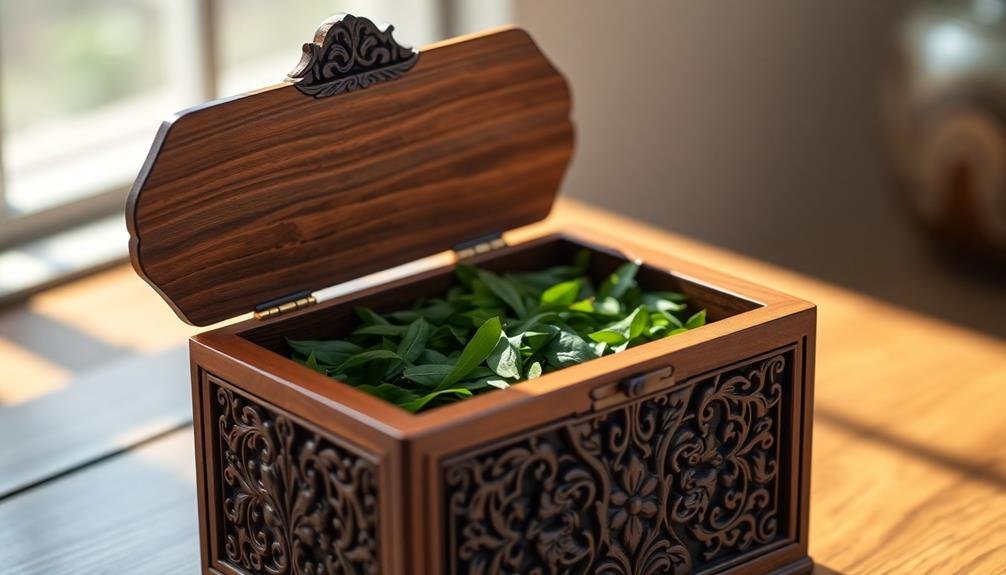
While the tea tray sets the stage for your ceremony, a proper tea storage container guarantees your leaves remain fresh and flavorful. Choose a container that's airtight and opaque to protect your tea from moisture, light, and air. Traditional options include ceramic, porcelain, or metal canisters, but modern alternatives like double-lidded tins are also effective.
Consider the size of your container based on how much tea you typically store. Smaller containers are ideal for frequent tea drinkers, as they minimize air exposure each time you open them. For variety, invest in multiple containers to store different tea types separately.
Here's a quick guide to tea storage containers:
| Material | Pros | Cons |
|---|---|---|
| Ceramic | Aesthetic, durable | Can be heavy |
| Metal | Lightweight, portable | May affect tea flavor |
| Glass | Visually appealing | Doesn't block light |
| Wood | Natural, aromatic | Requires maintenance |
| Plastic | Affordable, lightweight | May retain odors |
When selecting your container, prioritize functionality over aesthetics. Ascertain it seals tightly and is easy to clean. By properly storing your tea, you'll preserve its quality and enhance your overall tea ceremony experience.
Frequently Asked Questions
How Long Does a Traditional Tea Ceremony Typically Last?
You'll find that a traditional tea ceremony typically lasts between 1 to 4 hours. It's not a rushed affair; you'll experience a deliberate, mindful process that includes preparing, serving, and savoring the tea with reverence.
What Is the Proper Attire for Participating in a Tea Ceremony?
When attending a tea ceremony, you'll want to dress modestly and formally. Opt for subdued colors and avoid flashy jewelry. Women often wear kimonos, while men choose dark suits. Remember to wear clean, white socks for tatami rooms.
Can Tea Ceremonies Be Performed Outdoors or in Non-Traditional Settings?
Yes, you can perform tea ceremonies outdoors or in non-traditional settings. You'll need to adapt to the environment, but the core principles remain. Consider portable equipment and be mindful of weather conditions when planning your outdoor ceremony.
Are There Specific Rules for Guest Etiquette During a Tea Ceremony?
Yes, there are specific rules for guest etiquette during a tea ceremony. You'll need to be respectful, quiet, and attentive. Don't touch the utensils, follow the host's lead, and express gratitude for the tea and sweets you're served.
What Types of Tea Are Most Commonly Used in Formal Ceremonies?
You'll find matcha, a powdered green tea, as the most common choice for formal Japanese tea ceremonies. In Chinese ceremonies, you'll often encounter oolong or pu-erh teas. Each culture has its preferred varieties for these traditional rituals.
In Summary
You're now equipped with the essential tools for a proper tea ceremony at home. By investing in these seven items, you'll create an authentic and mindful tea experience. Remember, it's not just about the tools but the care and attention you bring to each step. As you practice, you'll develop a deeper appreciation for the art of tea. Embrace the ritual, savor the flavors, and enjoy the tranquility that comes with your home tea ceremony.


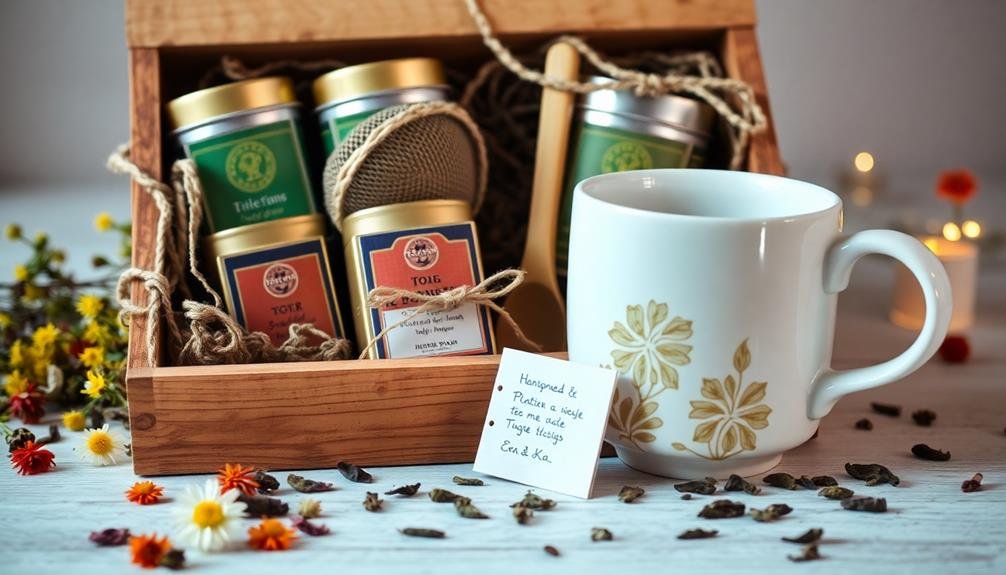
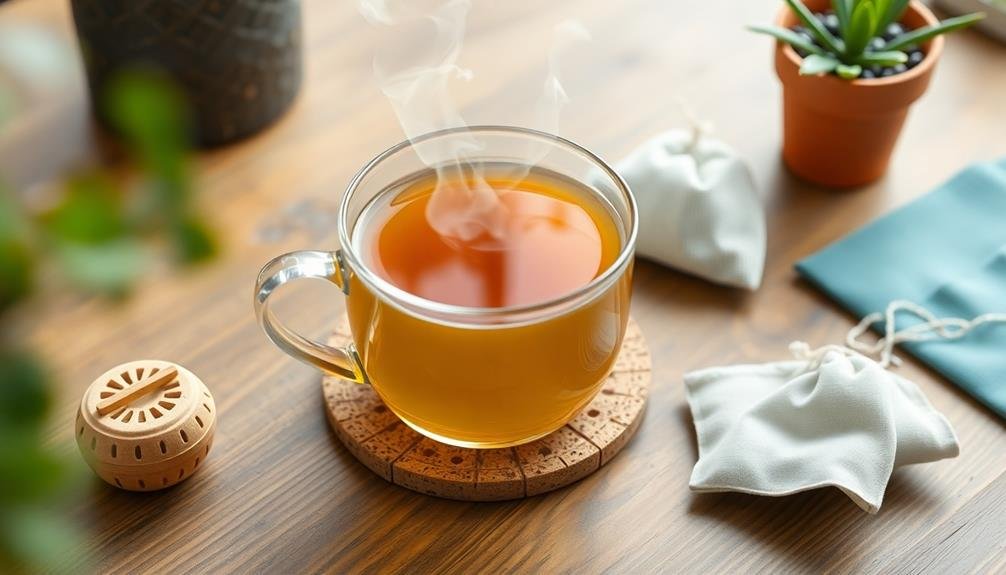
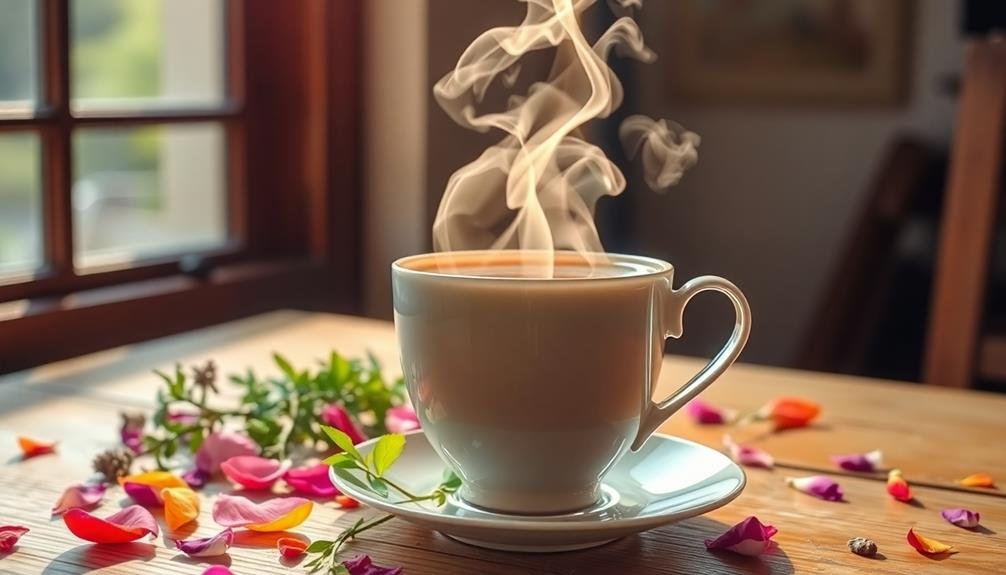
Leave a Reply